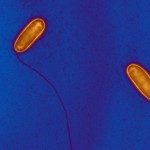Link to Pubmed [PMID] – 15317875
Mol Biol Evol 2004 Nov; 21(11): 2172-81
Reduction of the genome size in endosymbiotic bacteria is the main feature linked to the adaptation to a host-associated lifestyle. We have analyzed the fate of the nonfunctional DNA in Buchnera aphidicola, the primary endosymbiont of aphids. At least 164 gene losses took place during the recent evolution of three B. aphidicola strains, symbionts of the aphids Acyrthosiphon pisum (BAp), Schizaphis graminum (BSg), and Baizongia pistacia (BBp). A typical pattern starts with the inactivation of a gene, which produces a pseudogene, and is followed by the progressive loss of its DNA. Our results show that during the period from the separation of the Aphidinae and Pemphiginae lineages (86-164 MYA) to the divergence of BAp and BSg (50-70 MYA) the half-life of a pseudogene was 23.9 Myr. For the remaining periods of evolution, the ranges of values obtained for this parameter are of the same order of magnitude. These results have revealed that a gene inactivated during B. aphidicola evolution requires 40-60 Myr to become almost completely disintegrated. Moreover, we have shown a positive correlation between the decrease in the GC content and the DNA loss for these nonfunctional DNA regions. When gene losses are classified, based on the detection of a pseudogene or otherwise of an absent gene in the modern B. aphidicola genomes, we have observed a drastic reduction of DNA length in the latter versus the former relative to the functional gene. Finally, we have also detected a slight reduction in size of the intergenic regions in the three B. aphidicola strains, when they are compared with the size of the close relative Escherichia coli.

